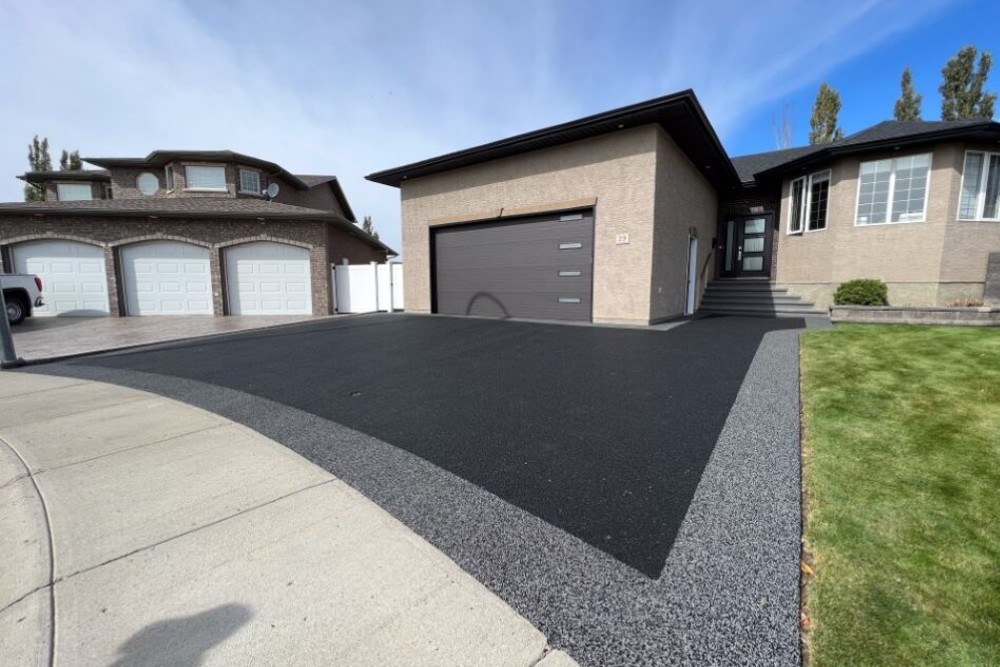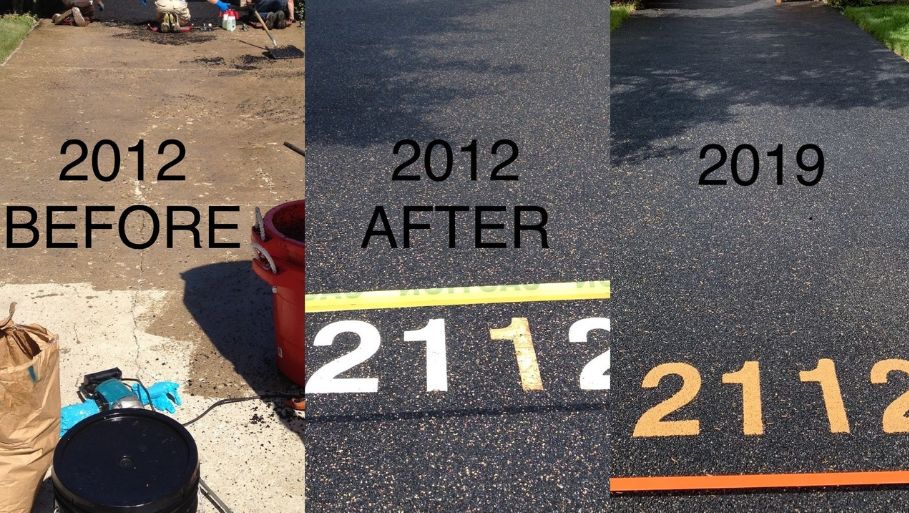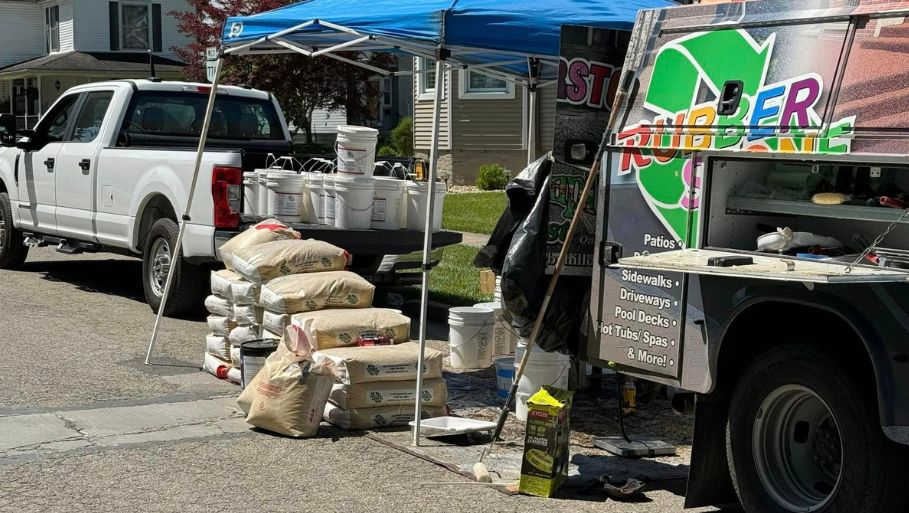Let's talk about pavers for a minute
If your patio, driveway, or walkway is made from pavers, you may have noticed cracks, shifting, or weeds squeezing through. Homeowners often look for new surface solutions because pavers can become uneven or tough to maintain as the years go by.
Rubber Stone offers a flexible resurfacing option that's quickly becoming popular for covering old pavers. It's made with real rubber and is designed to handle everything from heavy vehicles to wet pool decks, offering a safer, slip-resistant surface.
This guide is for anyone thinking about updating their concrete patio, walkway, or driveway with a fresh look. We'll break down the real pros and cons of installing rubber stone over pavers, so you can make a smart choice for your home. If you're exploring the benefits of using poured rubber surfacing over a pool deck, check out this Guide to Rubber Surfacing for Pool Decks for more details specific to that application.

What is Rubber Stone Surfacing and How Does it Work?
Rubber Stone is a practical, visually appealing alternative surface made from crushed recycled rubber and/or colorful EPDM rubber (ethylene propylene diene monomer) granules that are mixed with a binder. When applied over old or worn pavers, it gives patios, walkways, and driveways a completely new look while also making them safer and easier to maintain.
More about the rubber surfacing mixture
Our Rubber Stone blends two main ingredients: rubber and a high-strength polyurethane binder. The combination creates a surface that’s both sturdy and a bit “springy” when you walk on it. This unique mix provides the following advantages:
- Recycled Tire Rubber: Sourced from old tires, offering eco-friendly benefits.
- EPDM Granules: Add splashes of color and extra durability.
- Polyurethane Binder: Binds everything together into a seamless, flexible layer.
This system results in a surface that's comfortable to walk on, even barefoot, and is known for being slip-resistant. If you’re comparing rubber stone to traditional concrete driveway or patio options, I recommend taking a closer look at the comparison in this article on Rubber surfacing vs concrete.

How does installation over pavers work?
One big advantage of Rubber Stone surfacing, aka rubber asphalt, is that installers can lay it directly over existing pavers, saving you the hassle and cost of tearing out what’s already there.
Here’s how the process usually goes:
- Surface Prep: The paver surface gets cleaned, and any major gaps or sunken areas are filled.
- Mixing: The rubber crumb/EPDM granules are combined with the binder.
- Application: Installers trowel the mixture evenly over the pavers.
- Curing: The new surface needs time (about 24 hours) to cure and harden before use (a lot shorter than concrete!).
Because the finished surface expands and contracts with the pavers underneath, it can handle seasonal changes and heavy use without cracking. This means less future patching or repair work.

Where else can rubber surfacing be used?
Certified Rubber Stone installers have applied our poured-in-place resurfacing option anywhere you can think. From horse trailers to laundry rooms, driveways to pool decks, it can literally go anywhere. Here are some of the more common surfaces:
- Patios and Walkways: Makes backyard entertaining spaces more comfortable.
- Driveways: Handles the weight of cars and resists stains from oil and salt.
- Pool Decks: Stays cool in the sun and provides a slip-resistant area for wet feet.
- Garage Floors: Tough enough for layers of dirt, water, and tools.
Curious about where else you can upgrade your surfaces? Take a look at the full list of Rubber Resurfacing Options.
Pavers are just one type of surface that it can cover.

The Pros of Rubber over Pavers
Choosing to put down rubber over your old pavers comes with big perks for homeowners. Whether you want a stylish backyard, a safer walkway, or surfaces that last, rubber stone makes it simple to upgrade without a major renovation.
Booster Curb Appeal and Design Options
Rubber Stone transforms worn pavers into eye-catching outdoor spaces. It comes in a range of colors, textures, and patterns, so you can match your home’s style or try something bold. Whether you like earthy tones or a splash of color, options fit every taste.
Because rubber surfacing, or resurfacing, goes right over faded, stained, or cracked pavers, it covers up old flaws fast. Patios, driveways, and paths instantly look new, without tearing everything out. The slip-resistant finish adds security, while the seamless look hides problem spots that catch the eye.
- Hides old paver cracks, stains, and weeds
- Mix and match colors or create custom designs
- Adds modern curb appeal with slip-resistant finishes

Improved safety and Comfort
Rubber Surfacing is called safety surfacing for a reason. It's softer and safer than other traditional surfacing materials. Kids can run, play, or ride bikes safely, and the flexible surface cushions every step. It's much kinder on bare feet than concrete or brick.
Wet weather? No problem. Rubber stone is naturally slip-resistant, reducing the risk of slips near pools, on pool decks, or during rainy days. That's why it’s often the first pick for spaces where families gather or where children and pets play.
- Softer than tile, stone, or brick
- Reduces slips in wet or busy areas
- Makes outdoor living safer for all ages
Flexibility and Durability of Rubber Surfacing
Homeowners love that rubber stone stands up to all sorts of weather and heavy use. The rubber surface flexes with the ground during freeze-thaw cycles, which helps prevent cracks or splits that ruin the look and safety of traditional pavers.
Rubber stone resists damage from high foot traffic, parked cars, or rolling bicycles. It keeps looking good year after year with minimal touch-ups. For a closer look at its toughness around pools, patios, and decks, check out the guide on Rubber Surfacing for Pool Decks.

Faster Installation and Lower Maintenance Surface
With rubber, there’s no need to rip out existing pavers. Installers simply prepare the old surface and apply Rubber Stone right on top. Most jobs are wrapped up in just a day or two, which means little disruption to your yard or driveway.
Once it’s in, you’ll also appreciate how easy it is to keep clean. No grout lines or spaces to weed, just a seamless surface that only needs an occasional sweep and hose down.
- No demolition or mess because it is installed over the current pavers
- Most projects finish quickly
- Low maintenance and easy cleaning
Cons of Installing Rubber Stone Over Existing Pavers
It wouldn't be fair to point out the good and not the bad, so let's jump into what makes poured-in-place rubber surfacing less than ideal over pavers.
The initial cost is higher than just fixing the existing pavers
If cost is the main concern, you are better off just pulling up the cracked pavers and replacing them. For any pavers that have sunk or shifted, have those professionally repaired. This is the most cost-effective way to get your paver walkway, patio, or pool deck back in working order. Rubber Stone, and all rubber surfacing for that matter, will come with a higher price tag.
Professional installers are needed
While rubber stone is often marketed as a fast way to refresh pavers, it isn’t the best DIY project. This material calls for experience, the right tools, and perfect timing during the application and curing process.
- DIY attempts can lead to lumpy areas or poor bonding, which affects looks and lifespan.
- Professional crews know how to repair and prep pavers properly, then mix and spread the rubber stone evenly.
- Most installers guarantee their work, so you get peace of mind along with a great finish.
If you want the surface to last and look its best, hiring a pro rubber installer is a must. This helps avoid mistakes and gives you confidence that your new driveway, patio, or walkway will go the distance.

Conclusion
Rubber stone brings a lot to the table if you want to refresh old pavers. It hides cracks and weeds, adds a cushioning to your surface, and offers a range of colors to suit any space. While the cost is going to be higher than fixing a few pavers here and there, the comfort, safety, and easy upkeep make it a smart choice where looks and function matter.
If your pavers are mostly stable and you want to cover old flaws without tearing everything out, rubber stone is the way to go.
Want more homeowner stories, expert tips, and answers to common questions? Check out the Rubber Resurfacing Blog to keep learning and explore what’s possible for your space.
